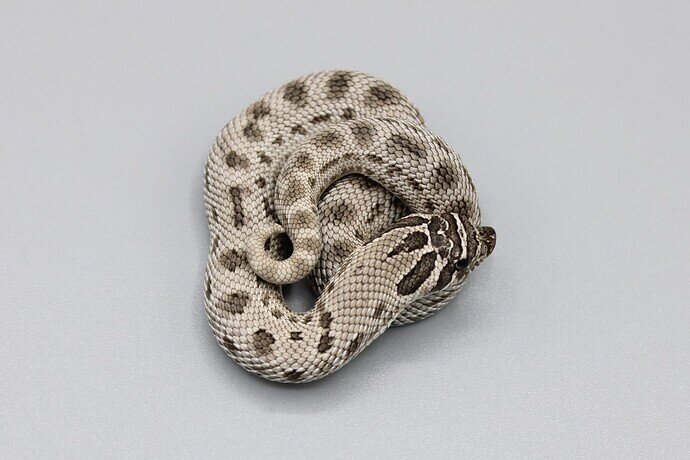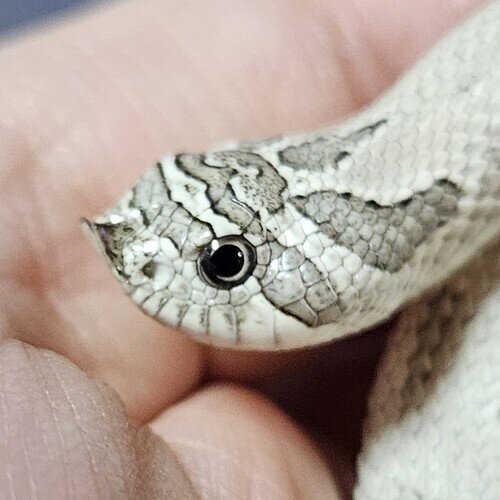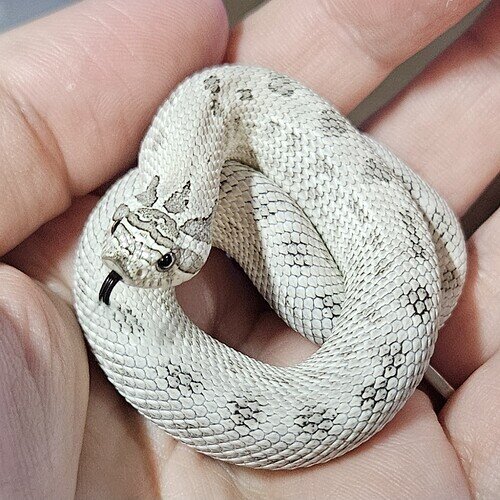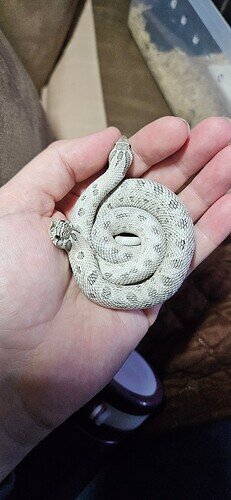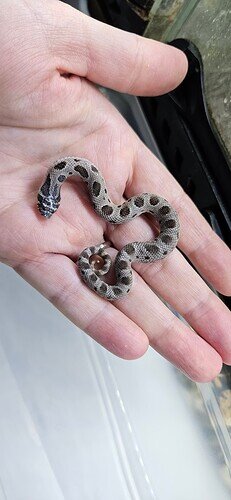How old is this information and do you have any references? I’ll admit I’m newer to hognoses, but I’ve never heard of something just called pastel that is polygenic and fades the dorsal pattern. The only mention of it I can find is from a hognose morphs website that has seemingly no public info on the ownership and cites no sources as to where their information came from.
There is RBE pastel, which I’m assuming is what’s being discussed. I feel it’s one of those genes that is easier to see in person. There are a couple breeders that incorporate RBE individuals in their lines that strongly represent the trait and it’s much more obvious then. I’ve only seen one RBE pastel in person and I could see a difference, but I can’t say I would have known it to be there if I wasn’t told that’s what the snake has.
Even though I have limited experience with pastel, I personally don’t think that’s in play here. Everything that could be argued as being pastel is also explained by the Arctic and conda that we know to be present.
This is why I hope RGI starts developing tests for other species soon because I want to test so many sheds ![]()
Except RBE Pastel is listed in the Morphpedia as being a dominant gene, not polygenic, and lists nothing about fading the dorsal pattern. I own an RBE Pastel girl so I’m not unfamiliar with the morph itself, visually. That’s why I’m a little confused as to what gene Don is talking about here. Being newer to hognoses, I want to learn as much as possible and I’m wondering if this is just something I’ve missed when doing research.
Fully agree with this, seems just like an exceptional expression of the known genes.
I feel that, I’ve got tons of question marks in my collection.
I believe that there is also a line bred pastel which is why RBE pastel has ‘RBE’ instead of just being called pastel
First let’s go back to me saying “it looks to me”. I made no assertions that the animal is in fact Pastel. I’ve only been in hognose for a few years but I’ve seen various pastel animals at shows and in a friend’s collection. In every instance I’ve seen it, it manifested exactly the way it looks in the pastel Axanthic conda I posted above. Lightens the overall color and fades the dorsal. I explained the effect as it was explained to me by Howard Leong of HC Premium Reptiles who I do shows with pretty frequently. He’s been breeding them since the early 2000s. I’ll probably see Jeff G. at the puyallup show in a couple weeks I’ll try to remember to ask him what his thoughts are on the subject.
This is really helpful, and I apologize if I came across as pushy, I didn’t mean to! The insight is very helpful, more than anything I was wondering if there was anything specific.
I would love to get Howard’s opinion, I had a boa from him years ago that i bought at the San Jose show. I’m a California native but have been in Wisconsin for almost 11 years and haven’t been in touch with breeders in the area since.
I appreciate your response! ![]()
Also, it may help to see how the sibling to this guy looks after she sheds (should be soon as she’s going into blue)
Update: Attached are images of the female sibling to the original male I posted about. The female is named Fontina and male is named Gruyère. Fontina shed on 1/19 and her pattern faded as well.
Photo the week that she was born:
Photos from tonight she shed on 1/19 (belly pic because its really pretty):
Pic with brother:
Gosh they are both so beautiful and I love the picture of them together ![]()
I do too! I just wish I knew the genetics! Although, now I might be able to convince my husband to let me invest in an adult axanthic female and another super arctic female to see what the father might produce from females without the watermelon.
Well you know now that both parents are het Axanthic, so that’s always a pleasant surprise!
Im not really sold on it that they axanthics! Since they weren’t really silver out the egg! Arctics usually do tend to change after growth shed! And when JMG first discovered arctic he called it jmg axanthic thinking it was axanthic until proven dominant! So it could just be very high expressions of arctic! I would personally reach out to JMG (Jeff Galewood) since he really is the expert on this
Axanthics do that. They can look almost brown or really dark grey out of the egg and then lighten up significantly as they grow.
Yes i do agree with that! And im not saying they arent axanthics…but i have seen some high expression arctics that really do look axanthic!!!
Gonna chime in and say I agree with @kaotik90 that I’m not sure Axanthic is present. There would need to be test breeding to confirm, and it’s far more likely that this is just a rather sublime expression of Arctic Anaconda and maybe something polygenic happening. The odds of both parents having a hidden het, especially one like Axanthic, are slim. Hongnose breeders tend to keep pretty good track of their genetics.
@sapphirereptiles can you get a picture of the whole clutch together, ideally in natural light? I think that would be tremendously helpful to see the comparison. Also would you mind if I were to send your pictures to a hog breeder friend of mine? He’s not on this platform but he has extensive experience with Arctic and Axanthic.
Im going to try and get some natural light pictures this weekend. Its been really nasty up here in the frozen tundra of Wisconsin. I still have a handful of these babies left (some were sold before this began to express a color change) and I’ll get pictures of them all.
I don’t mind at all if you share with anotherr breeder. I’d love any insight! I also plan to reach out to Jeff at JMG to see if he has some insight, I just haven’t had the opportunity to sit down and draft an email.
Luckily my booth was right next to to his so I spent quite a bit of time this weekend talking with my buddy Jeff from JMG Reptiles, going over the state of the union with how hognose morphs are currently categorized on MM. There’s definitely some work to do there.
As it relates to this discussion, ALL lines of pastel including RBE are polygenetic and not simply inherited. The look in question may not necessarily be from a specific line of pastel, it’s just something that pops up and can be line bred for improvement. It seems to also be related to extreme red/purple in some fashion, possibly they are the same thing.
Jeff is a really nice guy and he knows his stuff when it comes to hognoses. Definitely reach out to him!
I talked to my friend over the weekend and he said, that sure looks like arctic axanthic and really nice ones at that.
I bet you weren’t expecting all this excitement when the clutch hatched ![]()
I’m just kicking myself that I already sold four of them, one of which probably is expressing this same trait. At least it doesnt sound like it some new morph, still, lesson learned. I also hatched a Sable Shadow Conda Clutch (Father is Sable Conda x Mother is Het Sable Shadow). So those are not getting sold until they have a shed or two.
Some pics of a couple of those babies for fun. ![]()
I noticed that the hognose section on MM is a bit chaotic. It also doesnt help that they keep changing the menus.
I’m interested to hear more from Jeff, I’m still planning to reach out, just havent had the opportunity yet to compile everything into an email.
